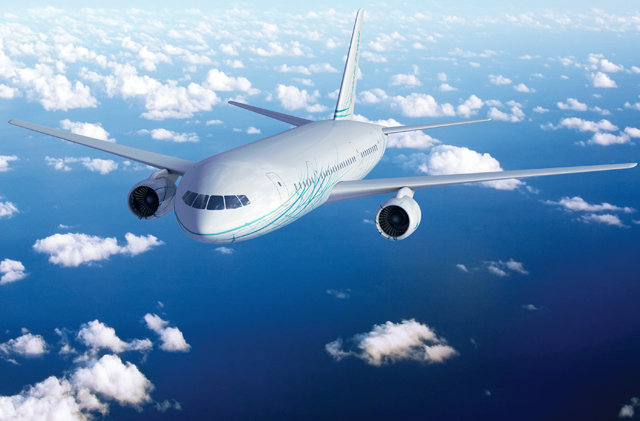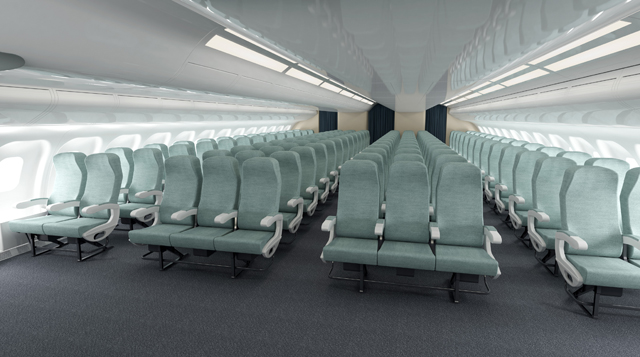Launching a three-aisle widebody airliner with a geometrically unique, ovular fuselage cross section always seemed an uphill struggle for a start-up Russian manufacturer, but the challenge in the end proved overwhelming.
“It is impossible to develop and create this kind of aircraft here,” says Sergey Grachev, director of marketing sales for Frigate Ecojet, a subsidiary of the Rosavia consortium.
The problem was not technical but geographic.
Despite a nearly 25-year relationship with Russian industry, Frigate Ecojet is moving out of Moscow office building near the Kremlin, and relocating to a still-undisclosed city in Europe. There, Frigate EcoJet plans to complete the definition phase for the medium-haul, widebody airliner, launch production, undergo certification testing with the European Aviation Safety Agency (EASA) and begin deliveries.

The Frigate Ecojet's unique oval fuselage could give airlines the opportunity to replace two closely spaced narrowbody operations with a single flight
Ecojet
If the plan succeeds, this renamed and updated concept originally launched by Tupolev as the Tu-304 in the early 1990s will open a whole new market segment for air transport in the early 2020s.
The business case for the aircraft has not changed. More than half of Airbus A330 and Boeing 787 fleets are operating routes under 2,000nm (3,700km), but are optimised to fly more than 6,000nm. This means the aircraft are heavier than necessary for the majority of the routes they are signed, Grachev says, adding: “Range is weight and weight is cost”.
Specifically, the average annual cost for one metric tonne of aircraft weight is $140,000.
This simple calculation drove Tupolev designer Victor Klimov in the early 1990s to design the Tu-304. Its ovular cross section is wide enough to accommodate 10-abreast seating in the economy cabin with three aisles. That allows the Frigate Ecojet to carry as many passengers as an A330-300, but weigh 17t less with the fuselage length of an A310-300 .
The trade-off for the reduced weight is significantly lower range. Frigate Ecojet is aiming to achieve a maximum range of slightly less than 2,000nm.
The vast difference in range performance could work to Frigate Ecojet’s advantage, Grachev says. The small, soon-to-be-immigrating Russian start-up has no ambition to compete against Airbus and Boeing in a head-to head competition. The goal instead is to persuade airlines to view the oval airliner as a complimentary asset to its existing widebodies rather than a direct competitor.
Grachev also proposes that airlines could replace two closely-spaced narrowbody operations with a single flight by the Frigate Ecojet.
“If you change two close flights for narrowbody for one aircraft like this you dramatically change the cost of seats down. It is not 5%. Sometimes it is up to 40%,” he says.
It’s no secret which widebody manufacturer Frigate Ecojet hopes to emulate the most. To help keep training costs low for airlines, Frigate Ecojet plans to seek a common type rating from EASA with another widebody. Grachev declines to identify which manufacturer, but notes that the Frigate Ecojet cockpit includes a sidestick control. That appears to align the Frigate Ecojet type rating with an Airbus cockpit, which also relies on a sidestick control.

The concept features a three-aisle cabin
Ecojet
The company still faces a long development period. It was expected to finalize the conceptual design by mid-year, the move into the definition phase. Despite the relocation to a European country outside Europe, Frigate EcoJet is still on track to complete first flight in 2018 or 2019 and reach entry into service in 2021, Grachev says.
Answering the question why Frigate Ecojet must decamp from Moscow is less straightforward for Grachev. “For you to best understand, I need at minimum three hours” to explain, he says.
But the move is essentially driven by the wide gulf in certification standards between Russia and EASA, which shares a bilateral agreement on type certification with the US Federal Aviation Administration (FAA).
Russian certification standards are not yet fully harmonised with airworthiness requirements set by EASA and the FAA. As a Moscow-based company, Frigate Ecojet is required to seek certification first by Russian authorities, then re-do at least 30% of the certification testing for EASA, he says. However, if the company is based in Europe, it can apply directly to EASA for a type certificate first, with relatively little additional work required to receive a reciprocal agreement from the FAA.
“It’s a different name, but the same procedure,” Grachev says.
Source: Cirium Dashboard



















